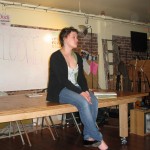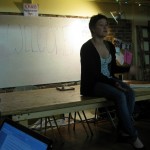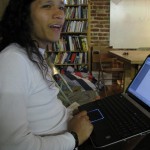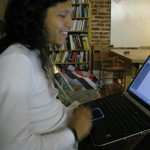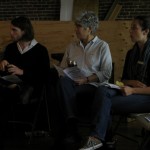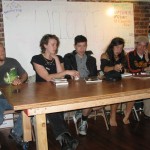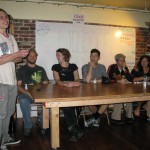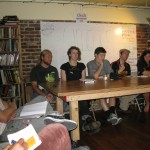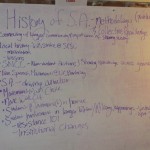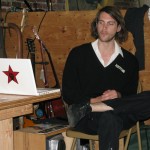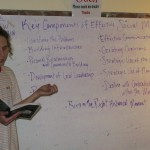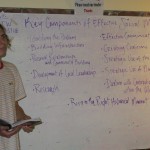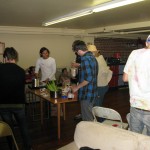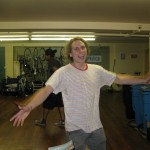 Check out this nice article that introduces various Indian empires that aren’t so well known.
Check out this nice article that introduces various Indian empires that aren’t so well known.
Category Archives: history
Bay Area Student/Activist Conference
Random Notes From May 6, 2012, Bay Area Activist/Student Conference
About 20 students and supporters in a cooperative event space in the Mission. Breakfast of donated pastries, peanut butter, and celery. Grew to 25-30 students by mid-day.
Activist panel: apocalyptic ecological scenarios, how to move past hopelessness, stop infighting, arguing over whose ideology is the best, each person contributes in their own way, solidarity, making compromises and sacrifices, collective ideal of utopian future, use that to decide when to compromise, revolutionaries need a clear collective purpose and focus to make decisions in a rational manner. Concept of a culture of resistance, normalize radical actions in the daily sphere of humans on the planet, a way to reduce risk as we escalate tactics. How do cultures of resistance relate to mass movements? How to get people involved? People’s privilege in the U.S. will have to be threatened until they don’t have a choice or is it a myth that people are too well off? That identifies the U.S. with white middle-class America. Different perspectives on privilege. But in history the struggles come from communities of color and those who have suffered oppression. Where is the force for change going to come from in the U.S.? When organizing is divorced from working class movements of color, then it won’t be as effective. We live in the greatest terrorist state that the world has ever seen, founded on the genocide of the native people who lived here. Privilege is corruption… it’s a matter of dismantling privilege. Many people see political organizing as ineffective, so how to get them to see their efforts as effective. When people with privilege ally with those who don’t have privilege, then it turns the system upside down. It confuses the police and the media. Concept of ally very important. Occupy using old tropes, rehashing old tactics, symbolic one-day marches and protests, think outside of the box. Lots of small actions in individual communities that are creative and involve people. People need to see a successful struggle. Sometimes that happens by models outside the US or movements within the US. Need to win enough struggles for people to have confidence in the struggle. Build base. Take context into account and think strategically about how we tailor our tactics to our goals, which requires identifying our goals in the first place. Mass demonstrations do activate people and make connections. But protest and demonstrations also perpetuate the idea that we live in a pluralistic, tolerant, democracy. One person said need to have a highly trained cadre to attack infrastructure. Another person responded about the farm, trespassing on land, don’t need Whole Foods, can grow your own food with people you just met, something hopeful to look at, not just symbolic. If mass underground action is happening, then the Occupations won’t seem radical anymore. What is the difference between an activist and an organizer? Core organizers vs. people who are just getting involved.
what are the strategies and tactics that can hit the 1% at their achilles heel in a way that the 99% can understand and support what we’re doing? level of paralysis that you can get by withholding labor, study what happened in Egypt and Tunisia recently, tactic of strikes, French labor strike in October, production-consumption capitalist based economy.
History of Student Activism
Tensions:
– privilege
– nonviolence v violence, every tool in the tool box, diversity of tactics
– institutional vs cultural change
* images of history like image of Malcolm X at SFSU Student Center
* living history: Black Panther visiting the campus
* 68 strike at State
* SNCC, wrote the book on nonviolent direct action
* free speech movement at UC Berkeley
* Latino walkout
* Chile, France, Quebec
* SDS
* Kent State Massacre
* Jackson State
Kent State students joined by locals in doing some “smashy smashy”
National Guard ordered in when ROTC building burnt. Lockdown of campus, not allowed on campus if not student, created a culture of fear and idea that they couldn’t resist, but they resisted anyway. People part of different resistance movements came together. No one expected the National Guard to fire, but they panicked, said rocks were thrown at them. They marched away to a field that was surrounded by a fence. Guards say they were not ordered, but 27 shot 67 rounds and killed 2 women and 2 men. After that, 4 million students went on strike, stepping away from campuses. Students had been organizing for the prior decade so networks were ready to be activated. Also had to do with the draft. Students exempt as long as they were in good standing. Constant state of fear over losing privilege and getting shipped to possible death in Vietnam.
Student privileges:
* Wealth of information at your disposal
* People in close proximity with infrastructure to form a community of resistance
Student disprivileges:
* Limited to when you are a student at university, transitory, temporary
* Isolated from labor, different views and experiences, issues of larger society
* Very busy, especially if also working to raise funds (in the 60s, public universities were practically free)
* Curriculum can be narrowly defined, limits on class offerings
* KONY 2012 style activism
* Student debt
History of SNCC, started nonviolent, opened to violent tactics
Did Freedom Rides in the South, despite facing lynchings, bombings, etc.
Once they started talking about black power, they started losing black power
Got rid of white folks in the organization, lost funding
They dropped out of school after the sit-ins in the 60s
Black Panthers
founded at Oakland City College (now known as Laney College)
using principles from Malcom X
moved into communities in Oakland
first open carry of guns at protest, self-defense stance
now illegal to have a gun within 100 feet of a university
providing useful infrastructure, feeding people
had most clearly articulated ideology: 10 point program starting with “we want freedom”
police and local authorities had shoot-outs
COINTELPRO hit them hard, disinformation
lessons: free breakfast program brought community together
lot of participants were agents provacateurs who gathered information and helped prosecute them afterwards
turn rage into something constructive
cultural change beyond political change
Weather Underground broke with SDS because they were militant
bomb attacks (see list on wikipedia)
1969-1976
used college education to navigate oppressive system
armed propaganda (only one person killed while putting together a bomb)
one captured of estimated 500 members
militant direct action
effect of student debt:
– atomizes students, “my debt”, have to get a job to pay for it
– brings people to point of being fed up, affects them directly
– can’t go into bankruptcy to get rid of it
– antithetical to the educational mission… a financial investment rather than a quest for knowledge and skills
– corporatization of universities
– what is the purpose of education in our society? just for diploma to get a job or for personal and societal fulfillment?
– US has highest cost for personal education in the world
– academic freedom
Key Components of Effective Social Movements
* Identifying the problem
* Building infrastructure
* Personal relationships and community building
* Development of local leadership
* Research
* Effective communication
* Creating coalitions
* Strategic use of the arts
* Strategic use of nonviolence
* Dealing with contradictions within the movement
* Being in the right historical moment
* use of murals: Diego Rivera and muralismo
* Bernal Library mural to be replaced in June
* chanting, short-lived, tiring, ugly, angry — replace it with singing, can sign all day long, beautiful
* administrators using structure to keep students from organizing, including even building architecture
Occupy critique:
– how to remain nonviolent, “violence” discredits what we’re trying to accomplish
– most of communication is non-verbal
– Occupy identified the problem that we have no control of our own lives
– camps example of taking control of our lives, participate in society that we want to live in
– take the public sphere back, return the commons to the people
– camps built personal relationships, community and coalition building
– got tied up in occupation of space, maintain as a tactic but not the only tactic
– strategy in a world that’s being privatized
– civil rights movement able to build a sense of solidarity and comradery with the people
– some people coming to Occupy sometimes don’t get a feeling of true community
– we are all occupying stolen land, unless you are native american
– creating 1% vs 99% meme
– horizontal model and consensus system very effective in demonstrating type of change people want to work for
Great panel on Privilege and Self-Oppression facilitated by Ramses.
Info on wheat pasting… it’s so easy!
Lunch With Andrew, Oxford and the Ashmolean Museum
Written June 21, 2008, on train from Manchester, England, to Holyhead, Wales, for ferry to Dublin, Ireland
After a good veg breakfast the next morning, I took two buses to Salisbury, then continued on to Oxford. I walked from the train station to the Ashmolean Museum, where I met Andrew Hodges for a pleasant lunch. We hadn’t seen each other for six or seven years since he stopped at Mills College as part of his lecture tour for his book on Alan Turing.
The Ashmolean has a wonderful collection of 25th dynasty materials, which I photographed along with a few contemporary Assyrian items.
On Andrew’s advice, I took a walk through town to see the old campus halls, the church, and other beautiful buildings. Then, back to the station and on to Manchester.
Silbury Hill, Avebury, and West Kennet Long Barrow
Written June 21, 2008, on train from Manchester, England, to Holyhead, Wales, for ferry to Dublin, Ireland
On the way to Avebury, we stopped at Silbury Hill, a grassy mound which is apparently the largest prehistoric mound constructed by people living in Europe.
At Avebury, the two women and I enjoyed a walk around the stones, those at Avebury far more deteriorated than those at Stonehenge. We visited the gift shop where we chatted with the friendly Irish proprietor.
They went on their merry way to Bath and I explored Avebury in more detail, skipping the museums, and meeting a delightful woman over lunch.
At her recommendation, I hiked through gated fields to the West Kennet Long Barrow, with its several subterranean chambers.
After the hike back, I caught the bus to Amesbury and chatted politics with an Australian fellow until the driver let me off just across the street from the B&B. I freshened up a bit, then decided to go out for another walk to see King’s Long? Barrows and Woodhenge.
On the way down the road to the trail gate, I ran into a cute French hitchhiker named Grégoire. After chatting a bit about the best place for him to camp if he didn’t get a ride, I asked if he wanted to join me on my hike. We settled mostly on conversation in French and he decided to go on the hike with me.
We checked out the barrows first, then after a couple of false starts, went to Woodhenge.
As we returned to the B&B, I agreed to fill up his water bottle, then invited to pay part of his meal if he’d join me at a pub in a hotel in town. I enjoyed getting to know him better over a cider and lasagna, then we walked back to the B&B where I had stashed his backpack and sent him off to go camping in the wild blue yonder. We agreed we’d try to meet again, possibly in Dublin.
Ritual Circle at Stonehenge
Written June 18, 2008, on the train From Liverpool to Manchester, England, United Kingdom
On the morning of Sunday, June 16, I woke up at 6:00 to get ready to leave the lodge by 6:30 for a brisk walk to Stonehenge. I walked on paths through sheep and cow pastures. I took some pictures of the sheep and the sun rising in the sky, then of Stonehenge and surrounding burrows (or burial mounds) from some distance away. Time grew short and I had to run the last half mile through sheep pasture to Stonehenge. I arrived just at 7:30 for the special early bird bisit with only about 10 other people. We paid a bit extra and reserved in advance for the privilege of walking in and around the stone circles and touching the stones. The massive stones, some fallen or covered in lichen, evoke a sense of mystery. Stonehenge radiates ancient energy, the sense that generations have stood hand-in-hand in circles within the stones for rituals of consuming importance.
The latest archaeological digs suggest the stones mark an ancient burial ground. The excavations also suggest the Cursus, a short distance away, was used for processions and possibly a settlement of some kind. Not much further away at Woodhenge, of which nothing survived except buried wooden post holes, now reconstructed with low concrete posts painted various colors. Nearby is Durring Walls, perhaps one of the largest prehistoric enclosure mounds.
After wandering through the stones at Stonehenge for quite some time and satisfying my yen for photos of the stones and of me posted with the stones, I got to chatting with some other visitors on that day from Slough, Germany, and Virginia. The two women from Slough were the most friendly. A site employee was checking pictures of the stones against the actual stones, so that any damage to the stones during the upcoming solstice celebrations could be logged. Last year, about 30,000 people visited Stonehenge for the solstice, the only time everyone can go right up into the stones for free. Chloe and ???, the women from Slough, offered me a lift and I told them I wanted to go to Avebury to see the large stone circle around the village there, along with nearbly Silbury Hill and the West Kennet Long Barrow. They decided to take a small detour on their trip to Bath to join me for the visit to Avebury.
On the drive to Avebury, we chatted about the differences between American English and English English. We decided to play a little game where I’d tell them about any cases where there were differences between the two dialects of English. I thought I’d only have to mention something every ten minutes or so, but it ended up more like every minute!

